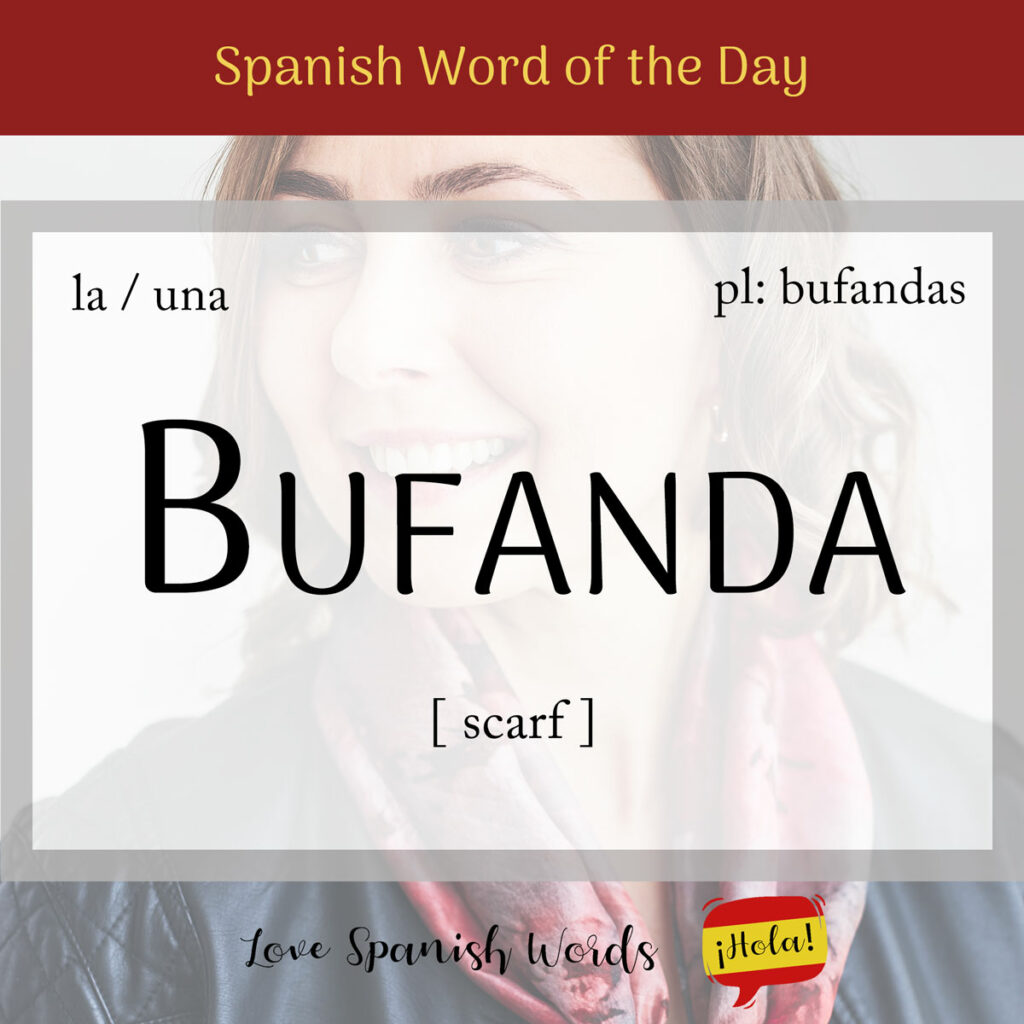In colder climates, we like to wear a scarf around our necks or heads to shield ourselves from the cold. This is typically a long piece of cloth made from heavy, thick material such as wool or fleece. In Spain, Mexico, Chile, and parts of Latin America, this scarf is called a bufanda.
It is possible the word bufanda comes from the old French word bouffante, which is the present participle of bouffer (to puff up or to be swollen).
Latin American pronunciation
European pronunciation

In English, the word scarf can be given to different types of neck and head wear, not just the long, thick, woollen variety. We will explore these different types and their Spanish equivalents further below.
Bufanda is a feminine noun and takes the following definite and indefinite articles:
- la bufanda = the scarf
- las bufandas = the scarves
- una bufanda = a scarf
- unas bufandas = some scarves
Cristina llevaba una bufanda roja de lana.
Cristina wore a red woollen scarf.
In October 2023, GQ México y Latinoamérica wrote an article about the types of bufanda which are currently in fashion (están en tendencia) for men this year. The list included:
- bufanda clásica de lana = classic woollen scarf
- bufanda de cachemira = cashmere scarf
- bufanda de punto grueso = chunky knit scarf
- bufanda de cuadros = chequered scarf
- bufanda de punto infinity o circular = circular scarf
- bufanda de punto fino = fine knit scarf

Synonyms of bufanda
As I mentioned earlier in the article, in English we use the word scarf for many different types of garment. In Spanish, bufanda has many synonyms (sinónimos) that describe different types of scarves. Some of these words are used more frequently in either Spain or Latin America, but most are universally understood across Spanish-speaking regions.
The pañuelo is what we would commonly call a headscarf in English, typically made of a light material like silk (seda) or cotton (algodón) and worn more as a fashion statement than for practical warmth. A pañuelo can also be worn on the head for hygiene purposes or for religious reasons. Additionally, pañuelo can refer to a handkerchief or a bandana in English.
The chalina is the most common word for a scarf in a large part of Latin America, with the most famous being the Chalina Tinisqa, a traditional scarf from Peru (bufanda tradicional peruana). The Chalina Tinisqa is a high-quality, colorful, handmade scarf made from alpaca wool and dyed using natural colors.
In Spain, the term chal, derived from chalina, is commonly used to refer to any type of woolen scarf worn across the shoulders.
A fular (or foulard using the French word) is a scarf for the neck usually made from silk or another fine material.
Other synonyms include pashmina, velo, tapaboca, echarpe and bufandilla.
Esa chalina tinisqa está exquisita. ¿Cuánto cuesta?
That scarf is exquisite, how much does it cost?

Interesting fact:
In Argentina, there is a feminist movement called Pañuelo Verde (green scarf). The movement has its roots in pro-choice and has spread across the whole of Latin America as a symbol of feminism.
The name Pañuelo Verde was inspired by the white scarves worn by Las Madres de Plaza de Mayo (The Mothers of Plaza de Mayo) during Argentina’s war (1976 to 1983). On the 30th April 1977, 14 mothers staged the first protest in the Plaza de Mayo because of the number of their children that had ‘disappeared’ as political prisoners.
Every Thursday at 3:30 pm since 1977, Las Madres de Plaza de Mayo walk around the Pirámide de Mayo in the center of the city of Buenos Aires wearing their pañuelos blancos (white headscarves). The march is open to anyone who wants to join.
In Spain, bufanda can informally refer to a bonus or perk of a job. Additionally, in a much more colloquial sense, it can be used to describe a backhander or a bribe.

